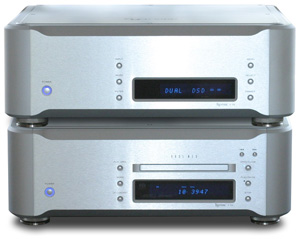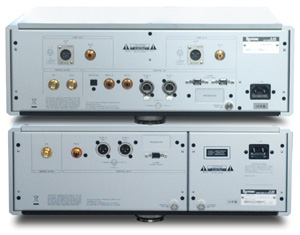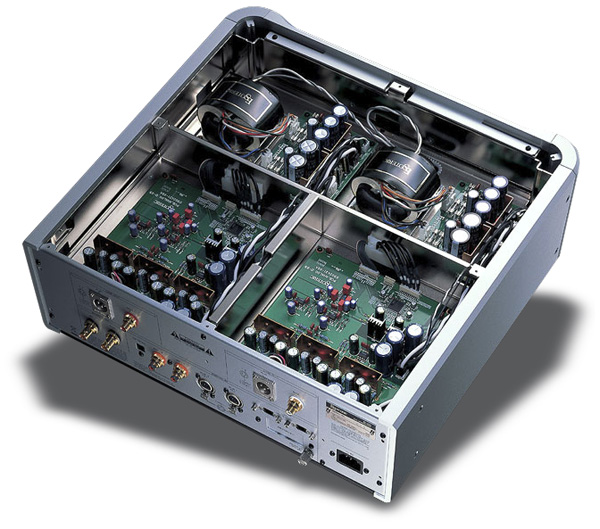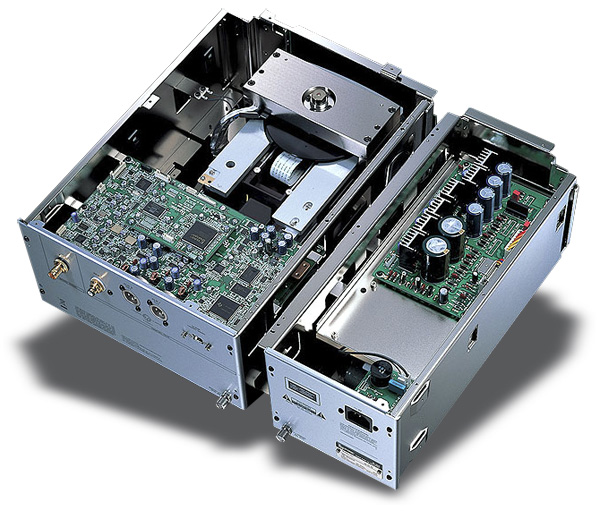![[SoundStage!]](../titles/sslogo3.gif) Home
Audio Home
Audio Equipment Review |
|||||||||||||||||||
You would have to be an audiophile living under a rock in a cave on another planet to have missed Esoteric's re-introduction to the US -- and all over the world. A brand of some renown in the mid-1990s, Esoteric was known for its cutting-edge digital products. However, its parent company, consumer- and professional-electronics giant TEAC, turned its resources away from its prestige hi-fi brand, only to relaunch it in style in 2002. The first of the new Esoteric products we encountered, the venerable DV-50 universal player, earned Reviewers' Choice honors for its sound, and its sturdy build became the standard against which digital products have been measured since. Esoteric has bettered itself several times since the DV-50's introduction, surely in no small part due to its own success. One well-received product spawns others, and the Esoteric product line now boasts of two separate series and over a dozen products, a couple of which are not strictly digital. Even so, the heart of Esoteric's current lineup is its collection of multi-format digital components that push the limits other Esoteric products helped set. Perhaps Esoteric's most advanced products are the new P-03 CD/SACD transport ($13,200 USD) and matching D-03 digital-to-analog converter (also $13,200). Even among their highly evolved and expensive siblings, the P-03 and D-03 stand out. The P-03 and D-03 were introduced earlier this year at CES, nearly simultaneously with their introduction in Japan, where Esoteric products hit the streets first. When you see them, you will understand Esoteric's desire to get the word out fast. Both are large, heavy components whose many design and user features can fill several pages of marketing literature. Or several paragraphs of a review The first thing that people will want to know is how the P-03 and D-03 handle SACD. That is, do they convert the DSD data stream to PCM, as Esoteric has done with other upscale components like the X-01, UX-1 and P-01/D-01 combo, or do they keep it in its native format? Even though the sound of Esoteric's digital products has been uniformly splendid, some audiophiles had a conceptual problem with the DSD-to-PCM conversion, which carried with it an air of [sniff, sniff] impurity. These people will be happy to know that the P-03 and D-03 do not convert DSD to PCM; in fact, they can convert PCM to DSD. Earlier Esoteric products used top-grade Burr-Brown DACs that could not decode DSD, hence the reason for the conversion to PCM. The D-03 uses Analog Devices AD1955 DACs that can handle DSD in its native form. You might be wondering, however, how the P-03 transport has any sway here; it simply outputs the data, right? Not quite. Before the data get to the D-03, the P-03 can output them as either DSD or PCM, and if PCM, at various sampling frequencies. Thus, while the P-03 and D-03 are separate devices and can work with other DACs and transports, they are very much meant to be used together. Aside from the format in which the transport outputs the data, there is Esoteric's proprietary ES-LINK, which piggybacks on the AES-3 scheme Esoteric first employed with the P-70/D-70 transport/DAC combo. ES-LINK requires connecting transport and DAC via a pair of AES/EBU cables and has a few important advantages over SP/DIF and other connection methods, one of which is particular to Esoteric's uppermost CD/SACD separates. First, it splits the digital stream into left and right channels, which allows for the output of PCM data upsampled as high as 176.4kHz. It also allows the output of SACD data, a feat that no standardized digital connection (TosLink, AES/EBU or SP/DIF) equals. The D-03 can decode DVD-A data, but the P-03 is not equally equipped. Enter Esoteric's P-03 Universal transport ($17,200), which adds DVD-A and DVD-V support.
While the P-03 and D-03 can be connected via standard SP/DIF or single AES/EBU cables, the two sound their best via ES-LINK and Word Sync connections. However, in this configuration, the pair only outputs stereo data. The P-03 is multichannel capable via its i.LINK output, but this requires connection to an i.LINK-capable multichannel receiver or processor. Esoteric's $25,000 P-01 transport is multichannel capable via AES/EBU outputs, while the X-01 Limited and UX-1 are less expensive ways to hear multichannel sound solely from Esoteric. Once you have connected the P-03 to the D-03, you have the choice of connecting the DAC to your preamp via XLR or RCA outputs. Like many Esoteric products, the D-03 is a fully balanced unit that uses multiple DACs per channel for the noise-canceling abilities of such a circuit, and this influences sound in very positive ways, something I comment on below. OK, if you've reached the point where you have the P-03 and D-03 properly connected to each other and the D-03 connected to your preamp, you're ready to begin experimenting with the various ways you can listen to music with them. Unlike most digital separates, the P-03 and D-03 allow you to change their sound in the digital domain, including how the transport sends data to the DAC, and how the DAC handles the data. Again, you can output data as DSD or upsampled PCM from the P-03; once the data are sent, the D-03 can convert them with or without digital filtering, which upconverts the PCM signal before it is converted to analog. Such flexibility can be interesting to have, but it can also be a nuisance. All those buttons practically beg you to push them! The P-03 and D-03 measure identically, 17 1/2"W x 6 1/4"H x 16 9/16"D, and weigh almost the same as well, 66 and 60 pounds respectively. Both employ 5mm-thick base plates and patent-pending steel footers with integral points and protective discs. Their outer brushed-aluminum panels and compartmentalized internal structure increase rigidity, mass and strength, reducing vibration and, according to Esoteric, "effectively [removing] all electrical interference." The aluminum top panel into which the Esoteric name is routed is 8mm thick.
The D-03 is a fully dual-mono design, with both channels sharing only the inputs, outputs and power cord. The right and left R-core analog transformers, the analog power supplies, the digital and analog circuits occupy identical internal cavities, use identical components, and have identical layout. Circuit highlights include the use of a highly accurate voltage-controlled crystal oscillator specifically designed for the D-03 to establish the unit's word clock and four Analog Devices AD1955 24-bit/192kHz DACs per channel in a quad-differential circuit. Only Esoteric's P-01 mono DAC, which uses eight (!) Burr-Brown DACs per chassis, shows greater audio obsessiveness than the P-03. Internal wire is of the same 6N, 99.9999%-pure copper as that in the P-01.
Like Esoteric's X- and UX-series products and the top-of-the-line P-01, the P-03 uses an Esoteric-designed and -manufactured VRDS NEO drive whose best-known feature is its disc-clamping mechanism. In the P-03's case, the transport mechanism has been beefed up. It features a turntable of duralumin, an age-hardened, aircraft-grade alloy, as opposed to the magnesium turntable used in other products, and a 20mm-thick SS400-steel bridge that controls vibration produced during the disc's playback. The P-03 has the same internal structure as the P-01, where the power supply and VRDS NEO mechanism are housed in separate isolated compartments. The P-03 accomplishes this by using two independent chassis within the same cabinet. For the P-01, the power supply is housed in its own cabinet. One feature that the P-01 doesn't share with the P-03 is the latter's "shutter," a hatch that flips open before the unit's machined-aluminum disc tray appears, and closes after it recedes. While Esoteric claims for the shutter the elimination of "adverse effects from external sound pressure and vibrations," I can attest to it being just plain cool, and sometimes that's all a feature has to be. Review system and setup I received the P-03 and D-03 following CES and shortly after the Esoteric X-01 Limited that I wrote about earlier this year. This gave me great opportunity to compare current Esoteric products to each other and to other top-flight digital sources, including an Ayre C-5xe universal player, Audio Research Reference CD7 CD player, and Aurum Acoustics Integris CDP CD player/preamp. I used all of the digital goodies with an Audio Research Reference 3 or Ayre K-1xe preamp, or the preamp side of the Aurum Acoustics Integris CDP. These sent the signals along to Lamm ML2.1, Lamm M1.2 Reference or Blue Circle BC208 monoblocks, or an Ayre V-1xe stereo amp. These drove four very distinguished speakers: Wilson Audio Alexandria X-2s, MAXX 2s or Sophia 2s; or Magnepan MG20.1/Rs. The Sophia 2s aside, these are very large speakers, but then so is my room: 20'W x 29'L x 10'H. Electronics rested on a Silent Running Audio Craz Reference equipment rack, with the Lamm monoblocks having pairs of Silent Running Audio Ohio Class XL Plus2 platforms custom made for them. The Ayre amp sat on two pieces of Corian, while the Blue Circle amps had only my room's carpet-over-concrete floor to support them. Interconnects and speaker cables for most of the time I used the Esoteric separates were Shunyata Research Antares Helix and Orion Helix, with Siltech SQ-110 Classic Mk II and LS-188 Classic Mk II used for a short period. A number of Shunyata Research power cords brought juice to the electronics, including Vx and Alpha variations of both the Anaconda Helix and Python Helix. The power conditioner was a Shunyata Research Hydra Model-8. When you take into consideration all of the features and connection schemes of the P-03 and D-03, there have to be hundreds of permutations and combinations for their use together. I experimented with many of them and discovered a few universal truths. First, because of its quad-differential circuit, the D-03 sounds best through its balanced outputs, and by a greater margin than any other Esoteric product I've heard. Anybody who tells you otherwise hasn't tried it, or hasn't listened closely enough. If you spend the money to own the P-03 and D-03, you should also spring for a reference-grade balanced preamp -- like the Audio Research Reference 3 or VTL TL-7.5 Reference Series 2. In terms of connecting the P-03 and D-03, ES-LINK via two AES/EBU cables is the only way other than i.LINK to send SACD data from the transport to the DAC. Good thing -- the DAC and transport sound far better connected this way than via single coaxial or AES/EBU cables. Esoteric recommends their own Mexcel cables for ES-LINK duty; Acrolink in Japan makes these (and supplies the wire used inside the P-03, D-03 and other Esoteric products). While I used a pair of Mexcel 7N-A2500 cables, I found that the DH Labs D-110, a true 110-ohm AES/EBU digital cable, worked very well and didn't leave me pining for the much more expensive Esoteric cables. Finally, clock-linking the two units provided a small but worthwhile increase in soundstage focus and overall speed, and the cost of this connection was only a BNC-terminated cable. Again, a DH Labs digital cable, the D-75, worked well. The final thing to consider with the Esoteric duo is whether to convert to DSD or PCM, and then whether to engage the D-03's digital filter. I listened to the P-03 and D-03 in just about every combination of settings; I preferred it with the P-03's output set to DSD and the D-03's digital filter turned on. However, with some CDs, turning the digital filter off actually increased presence and improved the sound. Owners, who will have endless access to both units and no writing deadlines to meet, may find some satisfaction in close listening to every possible combination, but settling on just one is where I suspect most will end up. "Set it and forget it," as Ron Popeil counsels. Needless to say, very few audio products are built like the P-03 and D-03, whose technical design seems equally refined. Esoteric products make their opulence known before they produce a sound, and the P-03 and D-03 have seemingly maximized this principle. Sound -- finally! Well, not quite. The P-03 and D-03 I received for review were the first units in the US, and while they had some playing time on them (they were used at CES in January), it wasn't much. Consequently, they initially sounded unfocused, polite and one-dimensional -- boring, in short. I knew I shouldn't jump to conclusions, but what I heard was so uninvolving, so wrong, that it had me questioning Esoteric's strategy of switching from Burr-Brown to Analog Devices DACs. So I put an SACD in the P-03 and played it on repeat for three days straight. The sound tightened up some after this, but not enough to make me want to listen. Back to the SACD (and then CD) on repeat for a few more days, during which time I worked on another review, forgetting about the P-03 and D-03 until I decided to mention them as ancillary gear in the review I was writing. I remember the afternoon clearly. I put on Over the Rhine's Drunkard's Prayer [EMI 72438-66233-2-4], a CD I had been listening to heavily, and sat down to take a quick listen. After five songs, I was astonished. The P-03 and D-03 sounded like a completely different, and much better, digital source. They were easily in the same rarified league as the other players I was listening to at the time. Break-in is by no means an absolute; most products benefit from it, but some require only a few hours and others weeks. Even so, the transformation is normally just enough to make me wonder if the product has broken in, or my ears have become accustomed to its sound. With the P-03 and D-03, the hairy caterpillar had turned into a tiger swallowtail, and another layer of this digital combination's complexity was revealed. Be sure to give the P-03 and D-03 lots of playing time before evaluating them seriously. The soundstage the P-03 and D-03 cast was as big as the room and speakers could support, and as detailed as the recording could convey. I heard a newfound sense of realism, spatial and otherwise, from the P-03 and D-03. However, they didn't derive this from the big things (subterranean bass depth, preternatural treble purity, a plush midrange, plunging and soaring dynamics), but rather through supreme overall aptitude and expertise at some meaningful small things: capturing the unique texture of a singer's voice, revealing the minute shifts in volume that happen in all kinds of music, conveying the sheen and shimmer of cymbals in a delicate yet steely way. The P-03 and D-03 express everything that defines the music they play, no matter how large or small. Earlier Esoteric products sounded more overtly detailed, fast, and dynamic. "Detailed, fast, and dynamic" apply to the P-03 and D-03, but they're the second, third and fourth things about their sound, taking a backseat to the obvious sophistication. Images were well delineated yet naturally rendered -- not the products of etch or crispy edge definition. This gave the music an easygoing character whose detail was evident but not highlighted for its own sake. Geoff Muldaur's Private Astronomy: A Vision of Bix Beiderbecke [Edge Music B0000907-02] is one of the best-sounding CDs of large-scale jazz I've ever heard. It achieves its stellar sonics by laying bare the performers, who populate an enormous soundstage. The P-03/D-03 duo excavated the large and small details that make this recording so invigorating, but never turned the horns brittle or the strings strident. The same is true for the SACD version of Eugene List's recording of Rhapsody in Blue, which shares space on a Telarc SACD with the label's famous first recording of Tchaikovsky's 1812 Overture [Telarc SACD-60646] -- yes, the one with the cannon shots that could make your tonearm jump out of the groove. Telarc has recorded Rhapsody a few times, but this version, their first, trumps all others to my ears, including the latest from jazz pianist Michel Camilo [Telarc SACD-63611]. I've heard List's performance dozens of times, with dozens of different digital components, but the P-03 and D-03 made hearing it on SACD something I'll remember -- and try to replicate after they're gone. The sound was precise and grand -- like List's playing. Bass was ridiculously deep and powerful, which, I speculate, is due to the care paid to the P-03's and D-03's power supplies. There are a few cuts on the Neville Brother's CD Family Groove [A&M 75021] whose bass weight and slam are amazing. "Day to Day Thing" can loosen the joints of my house if I lean on the volume hard enough, especially with the P-03 and D-03 spinning it. Bass definition and pitch were truthful but not overblown, as though they had to make up for less-than-acceptable depth. As with the rest of the P-03/D-03 combo's sound, the bass was cause for superlatives, but it was integrated with everything else -- "outstanding" not "out standing." As I've observed in other reviews, most multiformat sources don't have to make excuses for their CD playback any longer, and this means that reviewers don't have to make separate statements about it when writing about most CD/SACD players. The P-03 and D-03 are no exception -- everything I say above applies to their CD and SACD playback. Yes, a good SACD sounded better than a good CD, but the best examples of both formats attained a level of verisimilitude with the P-03 and D-03 that was state of the art. After a certain point, small gains in air or midrange palpability seem all the more superfluous when the overall product is within percentage points of ideal, which is perhaps the best way to sum up the P-03/D-03's sound. Which Esoteric? As many of you know firsthand, we answer a lot of e-mail, and we're glad to do it. I know that I would rather listen to music than wade through another review of a mono amp, so I'm happy to give you more listening time by simply answering questions sent my way as directly as I can. A question I often answer doesn't deal with one brand of component versus another, but two models from the same company. "How does the Wilson Audio Sophia compare to the WATT/Puppy 7?" Or "How does the Lamm M1.2 Reference compare to the ML2.1?" In these cases, you've already decided on a brand; you now just want to select the product that's most right for you. If someone could help me with such a dilemma, I'd send that person e-mail too. In this spirit, comparing the P-03/D-03 combo to Esoteric's X-01 Limited, which is the company's highest-performing single-box CD/SACD player currently on the market, seems logical. If I were considering the P-03/D-03, I'd want to know how the X-01 Limited measures up -- and know if I can save some money in the process. While expensive, the $14,000 X-01 Limited is a little over half the cost of the P-03 and D-03. It uses Burr-Brown DACs and converts DSD to PCM, so some sonic differences should be apparent. With the changes brought on by the Limited upgrade, the stock X-01 took a step toward a more relaxed, graceful sound. This is the same path the P-03 and D-03 take, to even greater effect. The X-01 Limited's soundstage is very good, but not as vast as that of the P-03 and D-03. Images are packed more tightly and don't achieve the same delineation as with the Esoteric separates. Soundstaging and imaging have a great effect on the entire sonic outcome, however; they create the context through which everything else passes. While characteristics like bass quantity and quality, and high-frequency air are similar (or even subjectively in the X-01 Limited's favor), the P-03/D-03's presentation is consistently more vibrant and polished, making each recording sound more distinct. But let's keep things somewhat in perspective. At this level of performance, and especially between products from the same company, differences are often small, more matters of opinion than signs of an undeniable pecking order. Such an argument could be made here: If I were writing the check, I would likely write it for the X-01 Limited as it represents the sweet spot in Esoteric's distinguished digital lineup. However, I cannot deny that the P-03/D-03 combo sounds better than the X-01 Limited in ways that are relevant to the enjoyment of recorded music, which is the heart of the matter. That this comes at a very steep price is no revelation. Conclusion TEAC has reestablished the Esoteric brand with a vengeance, and the latest Esoteric digital separates, the P-03 and D-03, only shove the throttle forward. It's impossible to see or read about the P-03 and D-03 and not be curious. They are big, gleaming pieces of audio treasure that are packed with well-considered design and user features, including industrial-strength upsampling, PCM-to-DSD and DSD-to-PCM conversion, a low-jitter connection scheme, and the ability to synchronize to a single word clock. But the P-03 and D-03 do not simply blind with science. Look past their technology and what you're left with is playback that conveys the distinctiveness of each CD or SACD in a composed, confident way. The sound of the P-03 and D-03 belies that of digital's past, and clearly betters much of its present. Esoteric has released a string of impressive digital players and separates since 2002, but, to my ears, none is as significant as the P-03 and D-03. They are arguably the most technologically advanced and best-sounding Esoteric products yet, which should elevate them to the top of any well-heeled audiophile's short list. ...Marc Mickelson
|
|||||||||||||||||||
|
|||||||||||||||||||
![[SoundStage!]](../titles/sslogo3.gif) All
Contents All
ContentsCopyright © 2006 SoundStage! All Rights Reserved |


 Like the
P-70/D-70, the P-03/D-03 combo can be tethered via a separate Word Sync connection. What
this does is link the two units to a single word clock that is kept in the DAC, so that
information doesn't have to be recovered from the digital data stream, reducing timing
errors, or jitter. With digital playback, the word clock's function is synchronizing
digital samples such that timing errors -- jitter -- are lessened before the signal is
converted to analog. A CD player's or DAC's word clock is where jitter takes its first
steps toward becoming audible and affecting sound in harmful ways. The Word Sync jacks on
the back of the P-03 and D-03 also allow for the use of an external clocking unit like
Esoteric's G-0s, which uses a highly accurate Rubidium oscillator. Such a device can
affect sound in positive ways.
Like the
P-70/D-70, the P-03/D-03 combo can be tethered via a separate Word Sync connection. What
this does is link the two units to a single word clock that is kept in the DAC, so that
information doesn't have to be recovered from the digital data stream, reducing timing
errors, or jitter. With digital playback, the word clock's function is synchronizing
digital samples such that timing errors -- jitter -- are lessened before the signal is
converted to analog. A CD player's or DAC's word clock is where jitter takes its first
steps toward becoming audible and affecting sound in harmful ways. The Word Sync jacks on
the back of the P-03 and D-03 also allow for the use of an external clocking unit like
Esoteric's G-0s, which uses a highly accurate Rubidium oscillator. Such a device can
affect sound in positive ways.
